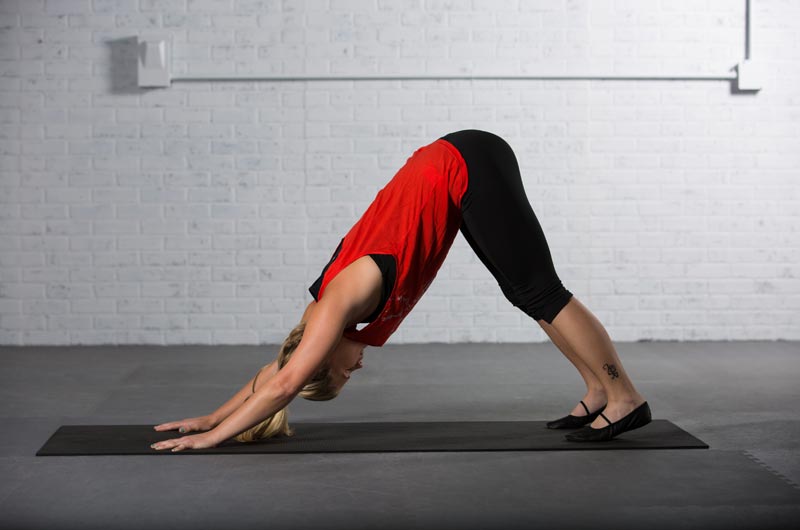An astonishing 80 percent of Americans—men and women of all ages—suffer from back pain. There are numerous reasons people experience acute and chronic back pain, including poor posture, injury, excess weight and structural deformities, such as scoliosis. Not surprisingly, lifestyle choices can help or hinder back discomfort.
Individuals who lead a sedentary lifestyle and/or work primarily at a desk are at particular risk for back pain because the body’s musculature adapts to the lack of movement, and sitting for long periods often results in a “hunched” spine and tight and weak muscles throughout the body. Yoga, however, can be a great way to counteract these negative effects.
The following yoga poses benefit spinal health by opening and lengthening muscles that connect, surround and intertwine the spinal discs. This specific routine focuses on opening the spinal column in various planes of motion and includes flexion, extension, lateral flexion and rotation of the spine. Stretches are most effective when held for 30 to 60 seconds and combined with deep breathing.
Note: If you suffer from back pain, consult your medical doctor on how to manage the pain. Pain specialists, physical therapists, chiropractors and specialized personal trainers can conduct a postural assessment and movement screen to unlock any muscular deviations or weaknesses that may contribute to back pain.
Head-to-hand Neck Release

Purpose: Lengthens the sides of the neck, chest, biceps and palms
How to Perform: Sit into a cross-legged position (or a chair). Bring your right ear toward the right shoulder. Lift the left arm to shoulder height and spread the palms with the thumbs facing up. Place the right hand lightly on top of the head and apply slight pressure, if necessary. Retract the left shoulder blade toward the spine and hold the posture. Repeat on the other side.
Revolved Head-to-knee Pose Variation

Purpose: Lengthens the obliques, neck and posterior muscles of the legs
How to Perform: Sit on the ground and place the legs into a straddle or “V” position. Place the right foot next to your left inner thigh. Lift the chest and slide the left forearm down the left leg and hold until you feel a stretch. Place the top of the right hand on the low back, near the left hip. Relax the shoulders and lower the left ear toward the left shoulder. You should feel a stretch in three areas: the back of the left leg, the right side body and the right neck. Hold the pose and repeat on the opposite side.
Cat Cow


Purpose: Flexes and extends the spine to increase mobility
How to Perform: Start on all fours with knees hip-width apart and hands shoulder-width apart. Start with a neutral spine; inhale deeply and then exhale as you round the back up toward the ceiling and the chin drops down to the chest. Inhale and lower the navel toward the floor and lift the chin upward. Continue flowing between cat and cow, matching the movement with the breath, for one minute.
Seated Spinal Twist

Purpose: Opens the external rotators of the hip, erector spinae and rhomboids
How to Perform: Sit on the floor with legs extended in front. Bend the right knee and place the right foot next to the left knee or inner thigh. Rotate your chest toward the inner thigh and place the left elbow on the right thigh. Place the right hand on the ground behind the body and look behind you. Repeat on the opposite side.
Downward-facing Dog

Purpose: Lengthens the posterior muscles of the legs and expands the chest
How to Perform: Start on all fours with knees hip-width apart and hands shoulder-width apart. Curl the toes underneath and lift the hips into the air. Think about lifting the tailbone toward the ceiling and roll the shoulders away from the ears. The chest should be relaxed as you do your best to maintain a neutral spine. Relax the heels toward the ground. Hold for three to five deep breaths.
Supine Revolving Spinal Twist

Purpose: Increases mobility in the thoracic spine
How to Perform: Lie on the floor on the right side of the body in a fetal position. Bend the knees to 90 degrees and place the arms straight in front the shoulder. To support your head, lie on a pillow on rolled towel. Inhale and lift the top arm up and rotate to the point of comfort. Some people can open completely into a lying spinal twist. Exhale and rotate back to center and re-stack the arms. Your gaze should follow the hand. Continue for 60 seconds and then hold open the spinal twist with either the left arm at shoulder height or by placing the left hand on the rib cage. Repeat on the opposite side.
 by
by 









 by
by